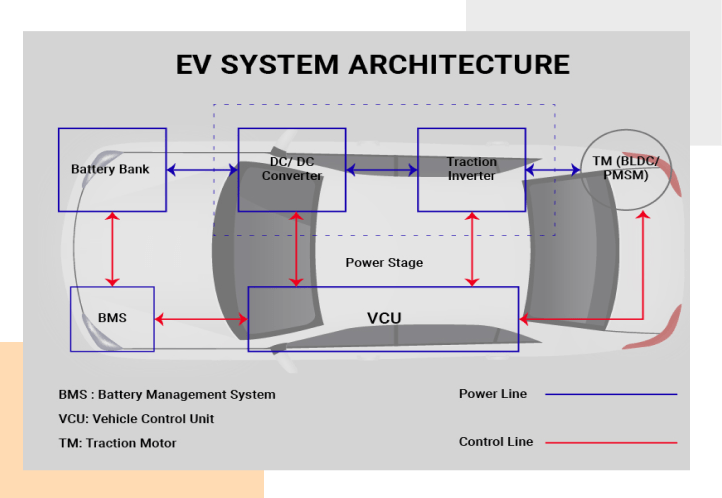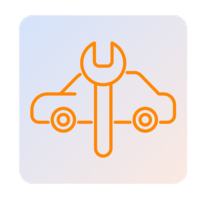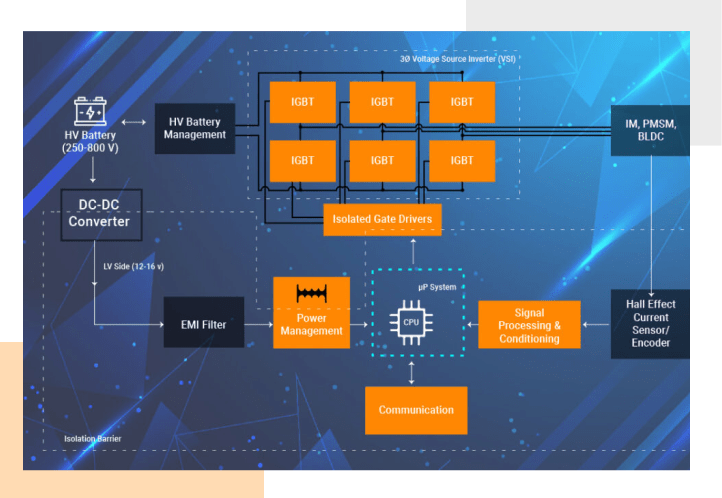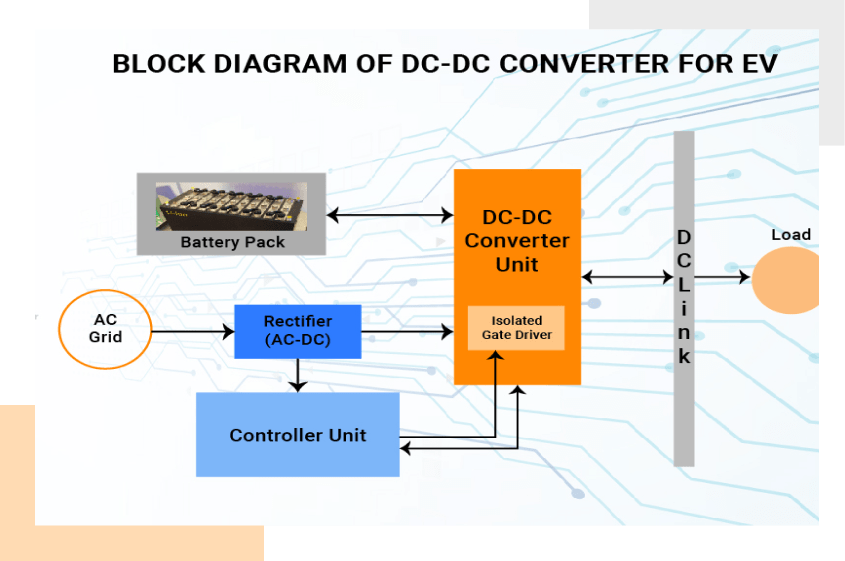Traction Inverter And DC-DC
Converter Solutions For
Electric Vehicles
An electric vehicle’s primary propeller are traction inverters, which deliver torque and acceleration. The overall experience of driving an EV and customer satisfaction are intimately correlated with the reactivity of the inverter and the electric motor it regulates.

Features of our EV Traction Inverter and DC-DC Converter solutions

Model Based Development (MBD) to give desire characteristics as per required customer data

Expertise in MATLAB simulation, Simscape tool for plant (EV) model

Supports MIL, SIL and HIL testing services

Reusable Models for customer convenience

Expertise in generation of SPWM, SVM, FOC algorithms

Selection of topologies as per requirement of customer data

Expertise in selection of Inverter rating as per customer specification / data

Supports all types of Motors (Induction Motor, BLDCM, PMSM, SRM)

Works as per ISO 26262 functional safety compliance
Interested in more details? Take it up with our consultants.
Traction Inverter for EV
Embitel, with an industrial experience of over 15 years, provide specialised traction inverter solutions to run the powertrains of contemporary electric vehicles. Our demonstrated skill in creating complex algorithms like FOC, guarantees a better functioning for your Electric Vehicles.
Our team has successfully delivered traction inverter solutions to electric vehicle projects all around the world. We respond quickly to our client’s needs because we build end-to-end inverter/converter solutions. So, if you want customized traction inverter solutions, with the correct switching sequence and FOC, you have come to the right place!
Various Components of an EV Traction Inverter
- High-power IGBT or SiC MOSFET power modules.
- High-voltage (HV) battery (48 V to 600 V)
- DC-link capacitor
- Sensing elements (Temperature sensor, Current Sensor, Voltage sensor, Position Sensor)
- Isolated Driver circuits
- Micro controller with power management IC
Technology Architecture of Traction Inverter for EV

Traction Inverter Solutions
Power Rating
Selection of Switches (Power Devices)
Control Algorithms
Model Based Development of Inverter
Power Rating
- Power levels up to 30 kW and above, these systems require extremely robust IGBT and silicon carbide (SiC) components.
- 48-volt to 600-volt batteries supply power to traction inverters, requiring inverter components to be rated from 120 volts to 750 volts while operating at current levels up to 500 A per phase.
Selection of Switches (Power Devices)
- A full ecosystem of parts to support wide bandgap power designs, including SiC diodes, SiC MOSFETs, and SiC Modules.
- MOSFET for Traction Automotive
- IGBT for traction Automotive
- SiC Modules for Traction Automotive
Control Algorithms
- Sinusoidal Pulse width Modulation (SPWM), Space Vector Pulse width modulation (SVPWM) control technique developed as per the application of inverter.
- Field Oriented Control (FOC) Algorithms:
- flux weakening for wider speed operation of traction drive.
- PI control with anti-windup, torque mode and speed mode.
- Space vector modulation.
Model Based Development of Inverter
- Provides the plant based MBD as per the customer Requirement.
DC-DC Converter
A type of power converter known as a DC-DC converter changes the voltage level of a DC source. It can be either unidirectional, which only sends power in one way, or bidirectional, which can do both. A DC-DC converter is also an essential part of a Battery EV’s architecture since it is needed to switch power from a high voltage (HV) bus to a 12V low voltage (LV) bus so that the LV battery can be charged, and the onboard electric devices can be powered.

Components of A DC-DC Converter
- High-power IGBT or SiC MOSFET power modules.
- High-voltage (HV) battery (DC Link) (48 V to 600 V)
- Inductor (High / Low frequency type)
- Power Diode
- DC-link capacitor
- Sensing elements (Temperature sensor, Current Sensor, Voltage sensor)
- Isolate Driver circuits for switching.
- Micro controller with power management IC
DC-DC Converter Solutions
Power Rating
Selection of Switches (Power Devices)
Controlled Technique
Model Based Development of Converter
Design Solutions
Power Rating
- Power levels up to 30 kW and above, these systems require extremely robust IGBT
- 96-volt to 600-volt from batteries, supplies power to Converter; components to be rated from 120 volts to 750 volts while operating at current levels up to 500 A.
Selection of Switches (Power Devices)
- A full ecosystem of parts to support wide bandgap power designs, including SiC diodes, SiC MOSFETs, and SiC Modules.
- MOSFET for Traction Automotive
- IGBT for traction Automotive
- SiC Modules for Traction Automotive
Controlled Technique
- Pulse width Modulation (PWM), control technique developed as per the application of Converter.
- As per the power devices (switches), switching frequency has been defined.
Model Based Development of Converter
- Provides the plant based MBD as per the customer Requirement.
Design Solutions
- Expected converter efficiency is more than 90%.
- Maximum Regulation of less than 5% selected for load and line regulation.
- Isolation circuits solution provides to prevent damage to components during fault if required.
Frequently Asked Questions (FAQs)
What does EV traction inverter refer to?
Ans. What is the definition of a traction inverter? When discussing electric vehicles, a traction inverter serves as a crucial power electronic component responsible for transforming the Direct Current (DC) provided by the vehicle’s batteries into an Alternating Current (AC) output.
How does the traction control function in Electric Vehicles?
Ans. The EV’s traction control systems consist of bi-directional inverter and converter components responsible for delivering the necessary power to the electric motors. These devices also facilitate the conversion of regenerative braking energy to charge the batteries, as well as handle the energy conversion during plug-in charging operations.
What is the function of the traction motor in Electric Vehicles?
Ans. The role of the traction motor in electric vehicles is to convert electrical energy into mechanical energy, enabling the vehicle to overcome obstacles such as aerodynamic drag, rolling resistance drag, and kinetic resistance.
What type of DC-DC converter is commonly utilized in Electric Vehicles?
Ans. DC-DC Converters for Electric Vehicles mostly revolves around the prevalent use of a particular circuit configuration known as the full-bridge DC-DC converter for power conditioning in fuel-cell systems that necessitate electrical isolation. The full bridge DC-DC converter is deemed appropriate for high-power transmission as it ensures that switch voltage and current remain within acceptable limits.
What is the purpose of DC-DC converters in EVs?
Ans. DC-DC converters play a central role in EVs, acting as a vital component that manages the batteries, supplying them with a high DC voltage. Given that the various components within EVs operate at different voltage levels, be it high or low, the implementation of DC-DC converters becomes necessary to ensure the stability and appropriateness of voltage for these components.
What are the three widely used categories of DC-DC converters?
Ans. In the realm of low-power DC-DC conversion applications, the primary means of modern power conversion involve three key types of power converters: buck, boost, and buck-boost. Nevertheless, certain electronic circuits necessitate power supplies that yield a negative voltage on the output side.


